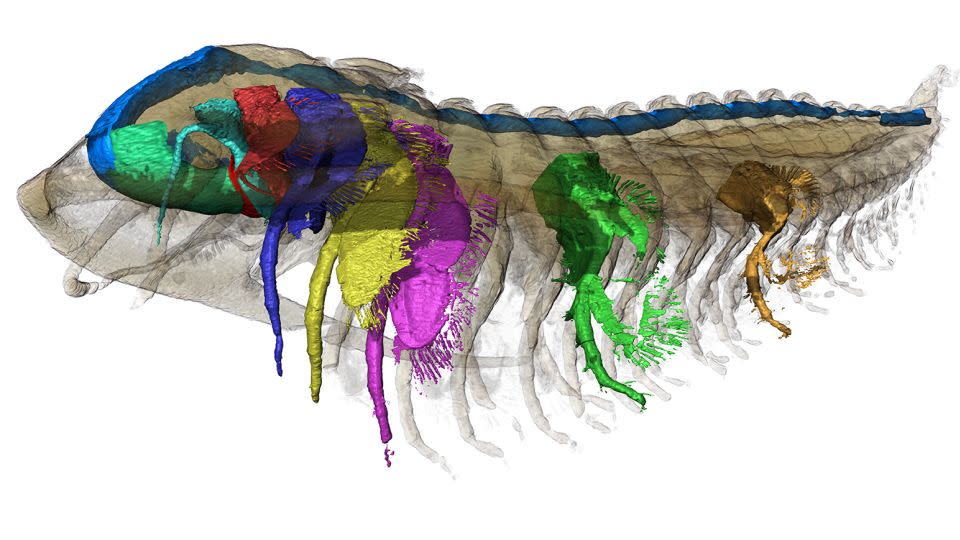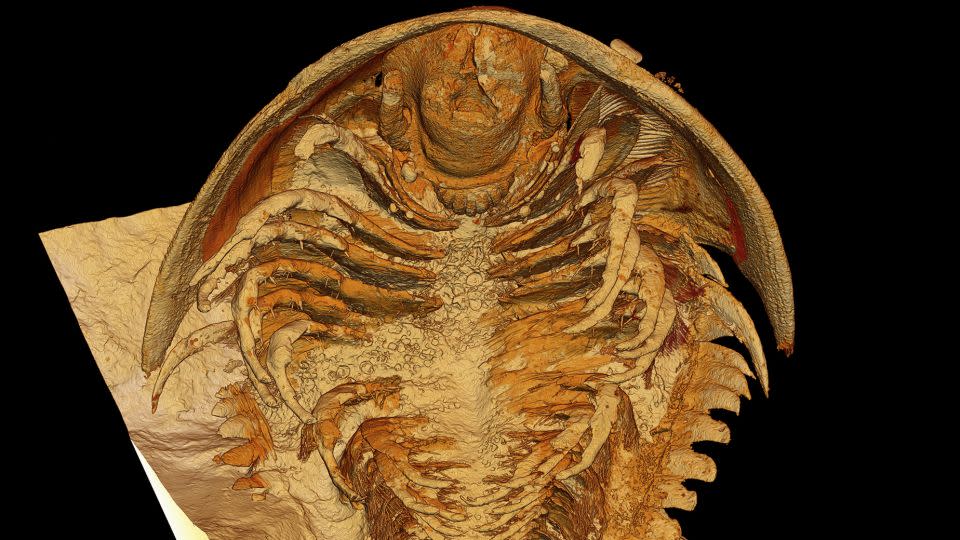Sign up for CNN’s Wonder Theory science newsletter. Explore the universe with news about fascinating discoveries, scientific advances and more.
A volcanic eruption nearly half a billion years ago near a shallow sea in what is now Morocco has preserved some of the most complete specimens ever found of insect-like marine creatures called trilobites, revealing anatomical details that scientists had never seen before.
Within minutes, a fast-moving stream of hot ash and volcanic gases called a pyroclastic flow engulfed the trilobites, which then cooled and turned into solid rock. The trilobites were instantly destroyed, similar to the people buried in the ash at Pompeii during the eruption of Mount Vesuvius in 79 AD.
For 515 million years, all evidence of these trilobites remained hidden, buried in an area called the Tatelt Formation in the High Atlas mountain range. But an international team of researchers recently used high-resolution X-ray microtomography to peer into the layers of the trilobite burials. The analysis revealed nearly intact 3D imprints of the animals’ vaporized bodies inside fragments of volcanic rock, the scientists reported June 27 in the journal Science.
From scans of these prehistoric casts, scientists reconstructed 3D digital models that show trilobite anatomy in unprecedented detail. The hot volcanic flow that buried the trilobites preserved traces of soft tissues that don’t usually fossilize, including intestinal organs, antennae, feeding structures, and tufts of sensory hairs and tiny spines on the trilobites’ appendages.
“It’s incredible that this was achieved in 3D with no modification or deformation,” lead study author Dr. Abderrazak El Albani told CNN. The detailed preservation showed that trilobites were anatomically advanced animals, with many specialized adaptations for feeding and moving on the seabed, he said.
Trilobites caught in an eruption of volcanic activity
Chemical analysis of oxygen levels in sediments in and around the samples revealed that the trilobites’ guts were full of ash, which the animals likely ingested as they suffocated to death from ash clouds in seawater, the study authors said.

The pressures of sedimentary layers typically flatten delicate fossils. But after the eruption buried the trilobites, cold seawater mixed with hot ash, rapidly hardening the pyroclastic flow into a solid rock burial. This prevented the trilobites’ molds from breaking down and preserved a nearly perfect imprint of their bodies, said El Albani, a professor of geology at the University of Poitiers in France.
The findings also highlight the urgency of protecting fossil-rich sites like the Tatelt Formation in Africa, El Albani added. Unlike the Tatelt, the Burgess Shale, a major Cambrian fossil site in Canada, is considered a UNESCO World Heritage Site. Such protections help ensure buried remains from Earth’s distant past remain accessible for future study, El Albani said.
‘Highly unusual’ discovery
Over the past 200 years, paleontologists have described more than 22,000 species of trilobites from sites around the world that were once covered by oceans. Trilobites were arthropods, like modern insects, spiders, centipedes, and crustaceans, and they evolved into a wide variety of shapes and sizes before going extinct about 252 million years ago. Most trilobite species grew no longer than 1 inch (2.5 centimeters), but some, such as Hungoides bohemicus, grew to be longer than 12 inches (30.5 centimeters).


Trilobites typically had hard exoskeletons that fossilize well. But soft tissue preservation in newly found trilobites is extremely rare, says Dr. Melanie Hopkins, curator of invertebrate paleontology at the American Museum of Natural History in New York City.
“Only a small fraction of trilobite species are well enough preserved for us to observe appendages,” says Hopkins, who studies trilobites but was not involved in the new research. “The level of detail preserved in the tadpole specimens is extraordinary, with some features that have not been observed before,” he says. Such features are critical for understanding how new traits and new species evolve, and for tracking relationships among arthropod groups, Hopkins adds.
“The more anatomical detail we have, the better we can make inferences about how fossil arthropods are related to each other.”
Trilobites had a stiff upper lip
Scientists found four trilobite specimens and described two species new to science: Gigoutella mauretanica and Protolenus (Hupeolenus) — the latter a known genus and an as-yet-unnamed species in the subgenus. The specimens ranged in size from about 0.4 inches (11 millimeters) to 1 inch (26 millimeters).
“This is the first time that the labrum, a bulging structure above the mouth sometimes called the upper lip, has been preserved in insects,” said El Albani. Behind the labrum, the oral slit was also perfectly preserved. Surrounding it were thin, curved appendages that were probably used for feeding and have not been previously identified in trilobite fossils, according to the study authors.
The discovery of these structures raises new questions about the diversity of trilobite feeding appendages, how this might have affected what trilobites ate and where they lived, and their sensitivity to changing environmental conditions if they had highly specialized diets, Hopkins said.
The suddenness of the Cambrian volcanic eruption even preserved evidence of neighbors sharing the trilobites’ marine habitat. The team found that one G. mauretanica trilobite had tiny shelled animals called brachiopods, about 0.04 inches (1 millimeter) long, still attached to its face. This example of commensalism (different species of animals living together) is also extremely rare in the trilobite fossil record, El Albani said.
“This is a unique window into the history of life in this specimen from 515 million years ago,” he said. “I hope that with other discoveries — by our team, by other teams in Morocco — we find more or different specimens, which will give us the opportunity to see more about their life history and evolution.”
Mindy Weisberger is a science writer and media producer who has written for Live Science, Scientific American, and How It Works.
For more CNN news and bulletins, create an account at CNN.com